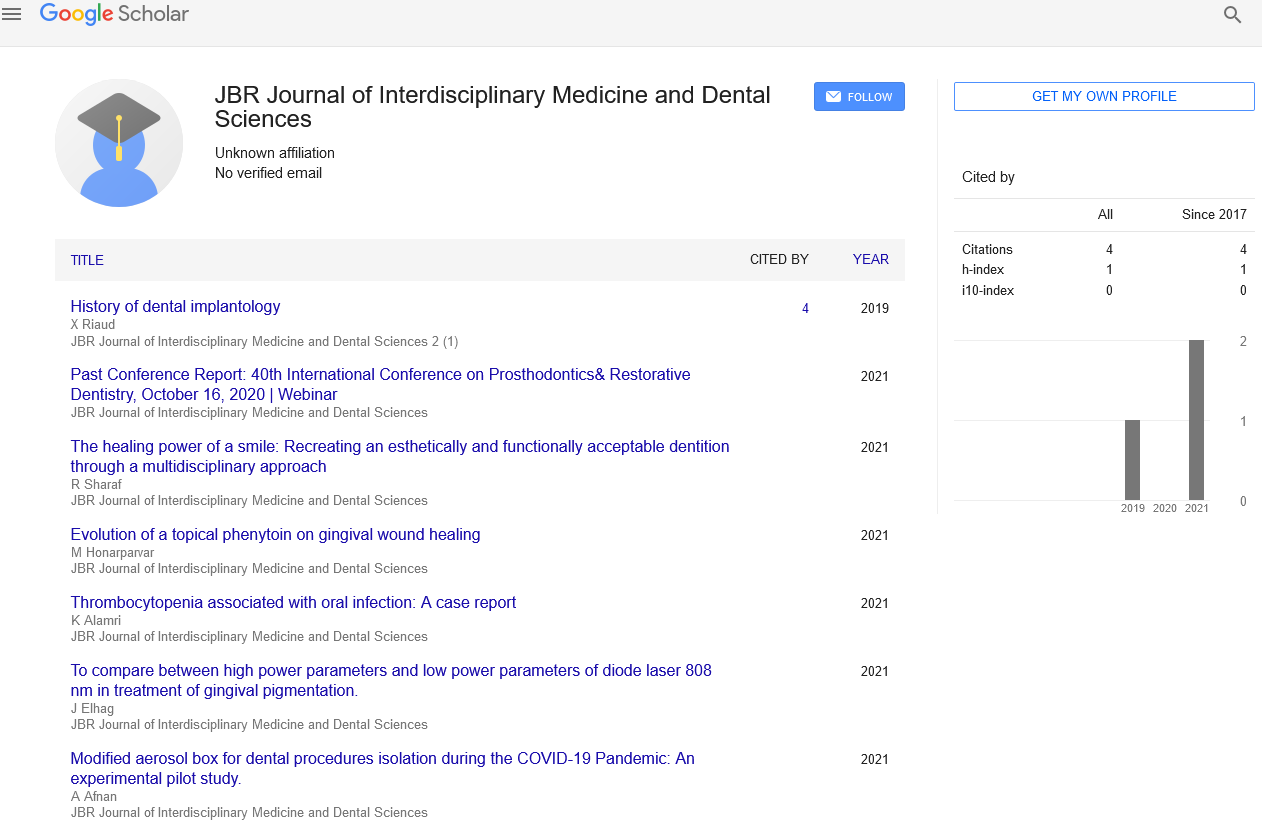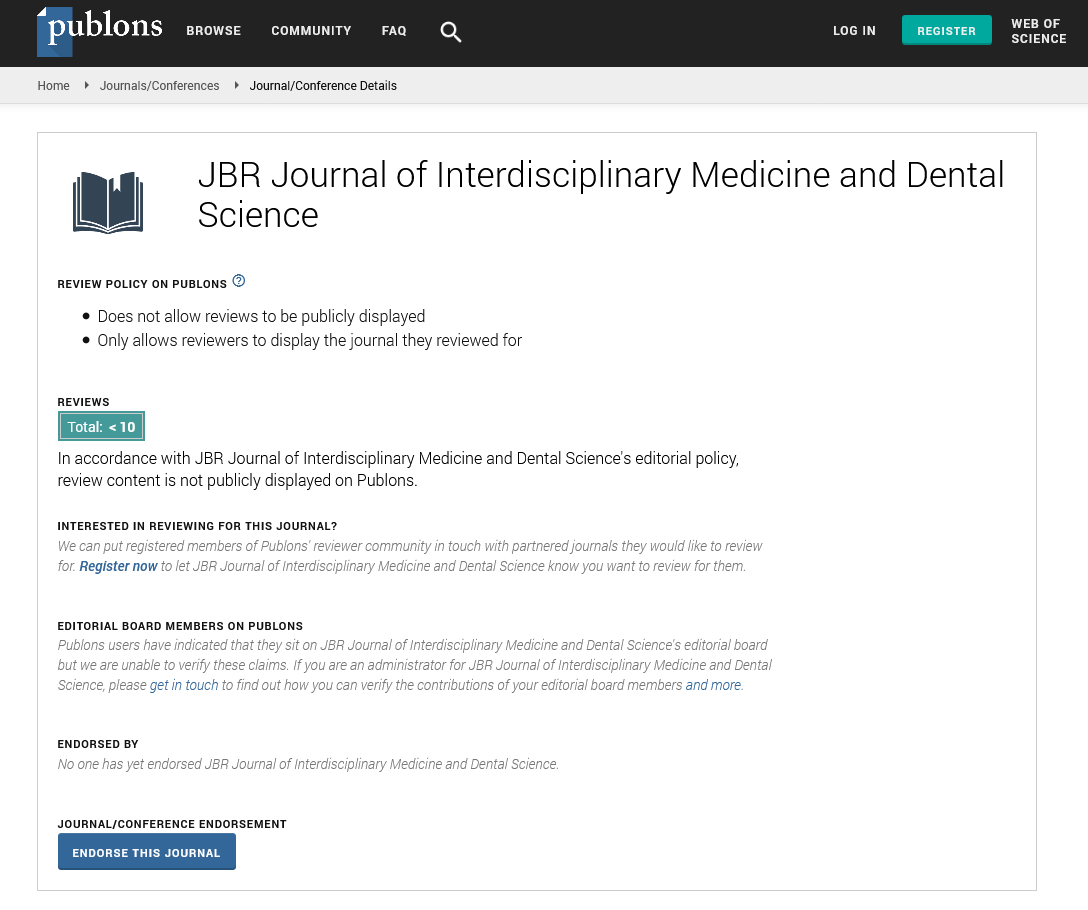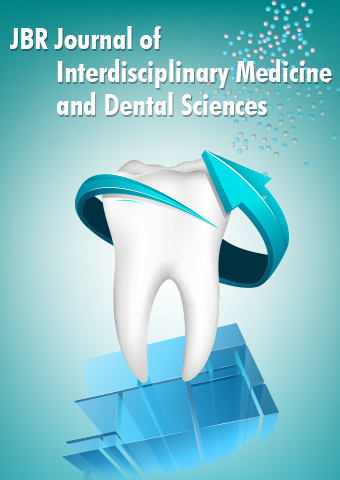Short Communication - JBR Journal of Interdisciplinary Medicine and Dental Sciences (2019) Volume 2, Issue 2
Caries detection: Specificity and sensitivity of the ICDASTM versus the DMFT index
Marcial Guiñez Coelho
Hoscar Carabineros Hospital, Chile
Abstract
Globally, untreated dental caries is the most common chronic disease in adults and untreated caries in temporary teeth is the tenth most common chronic disease. Some studies show that 100% of the study population is affected, although they are studies with a limited population It is a multifactorial disease determined by the relationship between protective and risk factors and considered a public health problem due to its prevalence, high cost of treatment, and because it affects people's quality of life . Caries lesions are a product of the biofilm that metabolizes sugars and produce acids, mainly lactic acid; this lowers the pH of the biofilm, creating conditions of subsaturation and demineralization, normally counteracted by remineralization phenomena. If this imbalance, in favor of demineralization, is maintained over time, the loss of minerals can progressively destroy dental tissues. In an initial stage the demineralization of the subsurface is greater than that of the surface, generating an initial lesion called white spot which is reversible through changes in hygiene, diet and remineralizing therapy. The demineralization process can take weeks, months or years before producing a cavitation or even never provoke it.
Introduction
Globally, untreated dental caries is the most common chronic disease in adults and untreated caries in temporary teeth is the tenth most common chronic disease. Some studies show that
100% of the study population is affected, although they are studies with a limited population
It is a multifactorial disease determined by the relationship between protective and risk factors and considered a public health problem due to its prevalence, high cost of treatment, and because it affects people's quality of life . Caries lesions are a product of the biofilm that metabolizes sugars and produce acids, mainly lactic acid; this lowers the pH of the biofilm, creating conditions of subsaturation and demineralization, normally counteracted by remineralization phenomena. If this imbalance, in favor of demineralization, is maintained over time, the loss of minerals can progressively destroy dental tissues. In an initial stage the demineralization of the subsurface is greater than that of the surface, generating an initial lesion called white spot which is reversible through changes in hygiene, diet and remineralizing therapy. The demineralization process can take weeks, months or years before producing a cavitation or even never provoke it.
Methods
A qualitative systematic review was performed with inclusion criteria such as descriptive and
experimental studies in Spanish and English with results under the dmft/DMFT and ICDASTM index, in vivo and ex vivo, and in humans. Exclusion criteria were studies older than 5 years (until 2013) and gray literature. A search was made in the Medline, ClinicalKey and SciELO databases with the keywords ICDAS, DMFT, dmft, ceod, COPD, caries, diagnosis, diagnosis, sensitivity, sensitivity, specificity and specificity.
The search showed 3.581 articles, 2.304 were discarded for their year, 159 for the language, 432 for not being human, 665 articles for their title and abstract. A total of 21 were read, of which 14 wer included because they met our criteria. For each of the selected articles, a critical evaluation of the literature was carried out. The analyzed studies consisted of 2 randomized clinical trials and 12 crosssectional studies. Of these, 7 were in vivo, 2 ex vivo and 5 in vivo and ex vivo. Most of the studies come from Brazil, where 753 people with ages ranging from 3 to 14 years were studied. To a lesser extent, studies from Asian countries where 2.995 people with ages ranging from 3 to 11 years were studied; and from European countries where 109 people with ages ranging from 2 to 55 years were studied.
Results:
The sensitivity and specificity of the dmft/DMFT index had a variation between 69.8%-73.2% and 69%, respectively, and ICDASTM between 55%-98.7% and 69.3%-100%, respectively, which increases with the operator's experience. In a study by Nogueira, et al.,
Undergraduate and postgraduate examiners who underwent ICDASTM training were evaluated before the training, on the day of the training and two years after the training. Undergraduate students had lower sensitivity than postgraduate students, suggesting that greater clinical experience influences caries assessment. These results were consistent with those found in the second and third evaluations where everyone had an improvement in their evaluations 2 years after the training. These results confirm that training, knowledge and clinical practice help to improve the detection of caries with visual methods.
Another study showed a higher prevalence of healthy teeth using DMFT achieving 96.2% and with ICDASTM 90.6%. The prevalence of carious teeth was higher with ICDASTM obtaining 7.8% and DMFT obtaining 2.2% with statistically significant differences. The same analysis in temporary teeth showed a higher prevalence of healthy teeth using the dmft index obtaining 80.6% and ICDASTM 75.8%. The prevalence of carious teeth was higher with ICDASTM registering 17.1%, in contrast, dmft registration 12.2% with statistically significant differences
Conclusion:
ICDASTM provides up to 43% more information when detecting non-cavitated lesions, but it requires more time to perform and more resources when using light, compressed air and preexamination prophylaxis, although it allows detecting initial injuries and performing preventive, non-invasive treatments and/or minimally invasive; treating the disease and generating changes in habits and consciousness in people, reducing economic costs and improving the oral health of the population, including helping to prevent other diseases with common risk factors such as diabetes and other associated with malnutrition. Most epidemiological studies are conducted in children and the most widely used index is dmft/DMFT.
The problem in using an index that only evaluates cavitated lesions with exposed dentin is that it categorizes a person as sick where the only possible treatment is an invasive, operative or surgical procedure. Considering that the first experiences are essential to determine the future behavior of individuals and submits a child to an invasive dental procedure, their future behavior and relationship with dentistry may be conditioned. Otherwise, if the population were analyzed using an index with an ability to detect injuries in early stages, allowing non-invasive and/or minimally invasive actions to be carried out during the first dental approaches to childhood, it would be possible to generate a better relationship between the child and dentistry, being able to promote greater adherence to treatment, treating disease and not just injury, raising awareness, not traumatizing during dental treatment, reducing people with fear of the dentist, and performing less expensive treatments, where invasive treatments only they are indicated for certain and specific situations, where the above failed.
Anatomically, the enamel of the temporary teeth is thinner and more porous, and has a lower mineral content than the permanent teeth, determining a faster progression of the caries lesion, being another reason to use an index that is capable of detecting lesions in initial stages in children avoiding theirrapid progression. Further comparative studies between ICDASTM and the dmft/DMFT index should be conducted to demonstrate differences in the specificity, sensitivity, and detection of carieslesions by studying representative populations.
References
- Angel p.; fresno m.; cisternas p.; lagos m. & moncada g. prevalencia de caries, pérdida de dientes y necesidad de tratamiento en población adulta mapuche-huilliche de isla huapi. rev clin periodoncia implanto rehab oral.,3:69-72, 2010
- Bhoopathi ph.; patil pu.; kamath bv.; gopal d.; kumar s. & kulkarni g. caries detection with icdas and the who criteria: a comparitive study. j clin diagn res., 11:9-12, 2017
- Castro als.; vianna mip.; mendes cmc. comparison of caries lesion detection methods in epidemiological surveys: cast, icdas and dmf. bmc oral health., 18:1-10, 2018
- Cerón-bastidas xa. el sistema icdas como método complementario para el diagnóstico de caries dental. ces odontología., 28:100-9, 2015
- Ferraz eg.; silva lr.; sarmento va.; de Jesus ce.; de oliveira tf.; magalhães jc.; paraguassú gm. & boa-sorte n. comparison of two visual methods for detecting caries among obese and nonobese children. acta odontol scand., 74:405-10, 2016
- Iranzo-cortés je.; terzic s.; montiel-company jm. & almerichsilla jm. diagnostic validity of icdas and diagnodent combined: an in vitro study in pre-cavitated lesions. lasers med sci., 32:543- 8, 2017
- Kassebaum nj.; bernabé e.; dahiya m.; bhandari b., murray cj. & marcenes w. global burden of untreated caries: a systematic review and metaregression. j dent res., 94:650-8, 2015
- Kidd eam. & fejerskov o. what constitutes dental caries? histopathology of carious enamel and dentin related to the action of cariogenic biofilms. j dent res., 83:35–8, 2004
- Melgar ra.; pereira jt.; luz pb.; hugo fn. & araujo fb. differential impacts of caries classification in children and adults: a comparison of icdas and dmf-t. braz dent j., 27: 761-6, 2016
- Ministerio de salud de chile. análisis de situación de salud bucal en chile., 1-11, 2010
- Nogueira vk.; bussaneli dg.; tagliaferro ep.; spin-neto r.; escobar a. & cordeiro rc. examiner's experience and the outcome interpretation of icdas and nyvad's system - a prospective in vitro study. acta odontol scand., 75:186-90, 2017
- Nordström m. caries prevalence dmft/dmfs. malmö university, 2014. disponible en: https://www.mah.se/capp/ methods-and-indices/for-measurement-of-dental-diseases/ for-cariesprevalence/.
- Olivan srg.; deana am.; pinto mm.; sfalcin ra.; fernandes kps.; mesquita-ferrari ra.; prates ra. & bussadori sk. diagnosis of occlusal caries lesions in deciduous molars by coherent light scattering pattern speckle. photodiagnosis photodyn ther., 18:221-5, 2017
- Pitts nb. & zero d. white paper on dental caries prevention and management - a summary of the current evidence and the key issues in controlling this preventable disease. fdi world dental federation, 1-60, 2016
- Potlia i.; kumar pgn.; prashant gm.; sushanth vh.; imranulla m.; mallick s. & rubel m. comparison of the caries status using dmft, icdas ii and cast index system. int j of adv res., 4:364-71, 2016
- Rodrígez g.; cabello r.; urzua i.; reyes m.; faleiros s.; ruiz b. & sanchez j. association between body mass index and caries lesions in preschool children in santiago, chile. inte. j. odontostomat., 11:369-75, 2017
- Singh r.; tandon s.; rathore m.; tewari n.; singh n. & shitoot ap. clinical performance of icdas ii, radiovisiography, and alternating current impedance spectroscopy device for the detection and assessment of occlusal caries in primary molars. j indian soc pedod prev dent., 34:152-8, 2016
- Teo tk.; ashley pf. & louca c. an in vivo and in vitro investigation of the use of icdas, diagnodent pen and cariescan pro for the detection and assessment of occlusal caries in primary molar teeth. clin oral investig., 18:737-44,2014
- Urzúa i.; mendoza c.; arteaga o.; rodrígez g.; cabello r.; faleiros s.; carvajal p.; muñoz a.; espinoza i.; aranda w. & gamonal j. dental caries prevalence and tooth loss in chilean adult population: first national dental examination survey. int j dent., 2012:1-6, 2012


